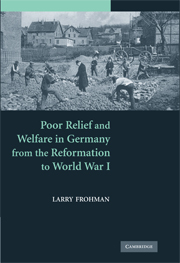Book contents
- Frontmatter
- Contents
- List of Tables and Figure
- Acknowledgments
- Introduction
- 1 Discipline, Community, and the Sixteenth-Century Origins of Modern Poor Relief
- 2 The Rise and Fall of the Workhouse: Poor Relief in the Age of Absolutism
- 3 Pauperism, Moral Reform, and Visions of Civil Society, 1800–1870
- 4 The State, the Market, and the Organization of Poor Relief, 1830–1870
- 5 The Assistantial Double Helix: Poor Relief, Social Insurance, and the Political Economy of Poor Law Reform
- 6 New Voices: Citizenship, Social Reform, and the Origins of Modern Social Work in Imperial Germany
- 7 The Social Perspective on Poverty and the Origins of Modern Social Welfare
- 8 From Fault to Risk: Changing Strategies of Assistance to the Jobless in Imperial Germany
- 9 Youth Welfare and the Political Alchemy of Juvenile Justice
- 10 The Social Evolution of Poor Relief, the Crisis of Voluntarism, and the Limits of Progressive Social Reform
- 11 Family, Welfare, and (Dis)order on the Home Front
- 12 Wartime Youth Welfare and the Progressive Refiguring of the Social Contract
- Conclusion: The End of Poor Relief and the Invention of Welfare
- Sources and Abbreviations
- Index
- References
2 - The Rise and Fall of the Workhouse: Poor Relief in the Age of Absolutism
Published online by Cambridge University Press: 17 July 2009
- Frontmatter
- Contents
- List of Tables and Figure
- Acknowledgments
- Introduction
- 1 Discipline, Community, and the Sixteenth-Century Origins of Modern Poor Relief
- 2 The Rise and Fall of the Workhouse: Poor Relief in the Age of Absolutism
- 3 Pauperism, Moral Reform, and Visions of Civil Society, 1800–1870
- 4 The State, the Market, and the Organization of Poor Relief, 1830–1870
- 5 The Assistantial Double Helix: Poor Relief, Social Insurance, and the Political Economy of Poor Law Reform
- 6 New Voices: Citizenship, Social Reform, and the Origins of Modern Social Work in Imperial Germany
- 7 The Social Perspective on Poverty and the Origins of Modern Social Welfare
- 8 From Fault to Risk: Changing Strategies of Assistance to the Jobless in Imperial Germany
- 9 Youth Welfare and the Political Alchemy of Juvenile Justice
- 10 The Social Evolution of Poor Relief, the Crisis of Voluntarism, and the Limits of Progressive Social Reform
- 11 Family, Welfare, and (Dis)order on the Home Front
- 12 Wartime Youth Welfare and the Progressive Refiguring of the Social Contract
- Conclusion: The End of Poor Relief and the Invention of Welfare
- Sources and Abbreviations
- Index
- References
Summary
Rethinking the Disciplinary Telos
The house of correction (Zuchthaus), or the workhouse (Arbeitshaus), as it is more commonly known, was the most important innovation in the organization of poor relief in the seventeenth and eighteenth centuries, and it was the cornerstone of public efforts to combat both poverty and vagrancy during these years. Although the workhouse has gone down in the history of the poor laws as an institution for the exploitation, oppression, and degradation of the poor, it has in recent years become increasingly clear that the house of correction was originally envisioned as something very different.
The first continental houses of correction were primarily founded as institutions of moral betterment and social reintegration, not as institutions of retribution. They embodied a characteristically early modern form of paternalistic social governance in which Christian magistrates of all confessions regarded it as their right and duty to guide the private lives of their subjects in order to promote the spiritual and material well-being of both the individual and the community. This solicitude could assume many different forms, ranging from material assistance to the deserving via education, chastisement, and correction for the wayward all the way to the punishment and exclusion of the incorrigible. The threat of correction was always latent in the offer of assistance and education just as the most rigorous measures to repress and punish vice always contained within themselves, if only in a highly attenuated form, the promise of rehabilitation and social salvation.
- Type
- Chapter
- Information
- Publisher: Cambridge University PressPrint publication year: 2008



